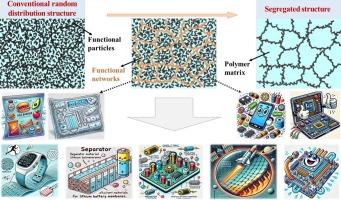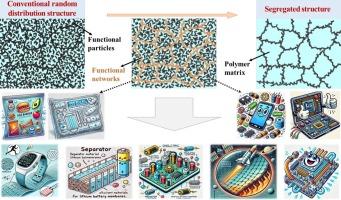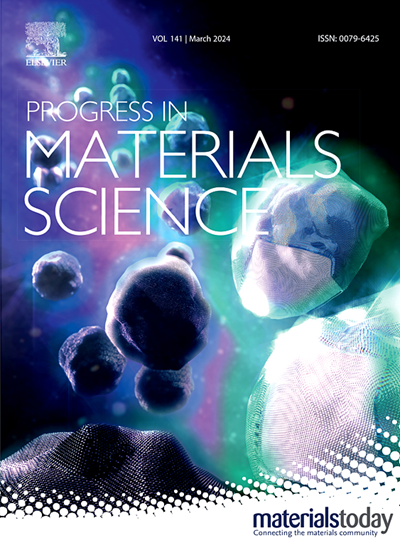Recent progress on segregated polymer composites for functional applications
IF 40
1区 材料科学
Q1 MATERIALS SCIENCE, MULTIDISCIPLINARY
引用次数: 0
Abstract
Polymer composites embedded with functional particles (e.g., conductive, thermally conductive, or magnetic fillers) integrate the processability of polymers with the tailored functionalities of these additives. However, conventional composites often necessitate excessively high loadings to establish percolation networks, leading to challenges such as increased costs, diminished mechanical performance, and compromised processability. Segregated structures-where particles are selectively localized at polymer domain interfaces-significantly enhance filler utilization efficiency, outperforming traditional composites with uniformly dispersed particles. Since our group’s seminal 2014 review on electrically conductive segregated polymer composites, extensive advancements have been achieved across diverse applications, including electromagnetic interference shielding, thermal management, and gas barriers. Innovative processing strategies have also been tailored to accommodate various polymer matrices. Despite these breakthroughs, critical gaps persist in understanding the mechanistic interplay and scalable fabrication of multifunctional segregated systems. This review systematically synthesizes the progress in segregated polymer composites over the past decade, emphasizing novel fabrication techniques, matrix-dependent design principles, and emerging functional applications. We critically analyze persistent challenges-such as interfacial control, and scalability-alongside recent solutions and evolving research trends. By elucidating structure–property correlations and offering actionable design guidelines, this work aims to drive the broader adoption of segregated structures and accelerate the development of next-generation high-performance functional materials.


功能型分离聚合物复合材料研究进展
嵌入功能性颗粒(例如,导电、导热或磁性填料)的聚合物复合材料将聚合物的可加工性与这些添加剂的定制功能集成在一起。然而,传统的复合材料通常需要过高的载荷来建立渗透网络,从而导致成本增加、机械性能下降和可加工性受损等挑战。分离结构-颗粒选择性地定位在聚合物域界面-显着提高填料的利用效率,优于均匀分散颗粒的传统复合材料。自2014年我们对导电分离聚合物复合材料进行了开创性的回顾以来,在电磁干扰屏蔽、热管理和气体屏障等各种应用领域取得了广泛的进展。创新的加工策略也被量身定制,以适应各种聚合物基质。尽管取得了这些突破,但在了解多功能分离系统的机制相互作用和可扩展制造方面仍然存在关键差距。本文系统地综述了近十年来分离聚合物复合材料的研究进展,重点介绍了新型制备技术、依赖于基体的设计原则和新兴的功能应用。我们批判性地分析了持续存在的挑战,如界面控制和可扩展性,以及最近的解决方案和不断发展的研究趋势。通过阐明结构-性能相关性并提供可操作的设计指南,这项工作旨在推动分离结构的广泛采用,并加速下一代高性能功能材料的开发。
本文章由计算机程序翻译,如有差异,请以英文原文为准。
求助全文
约1分钟内获得全文
求助全文
来源期刊

Progress in Materials Science
工程技术-材料科学:综合
CiteScore
59.60
自引率
0.80%
发文量
101
审稿时长
11.4 months
期刊介绍:
Progress in Materials Science is a journal that publishes authoritative and critical reviews of recent advances in the science of materials. The focus of the journal is on the fundamental aspects of materials science, particularly those concerning microstructure and nanostructure and their relationship to properties. Emphasis is also placed on the thermodynamics, kinetics, mechanisms, and modeling of processes within materials, as well as the understanding of material properties in engineering and other applications.
The journal welcomes reviews from authors who are active leaders in the field of materials science and have a strong scientific track record. Materials of interest include metallic, ceramic, polymeric, biological, medical, and composite materials in all forms.
Manuscripts submitted to Progress in Materials Science are generally longer than those found in other research journals. While the focus is on invited reviews, interested authors may submit a proposal for consideration. Non-invited manuscripts are required to be preceded by the submission of a proposal. Authors publishing in Progress in Materials Science have the option to publish their research via subscription or open access. Open access publication requires the author or research funder to meet a publication fee (APC).
Abstracting and indexing services for Progress in Materials Science include Current Contents, Science Citation Index Expanded, Materials Science Citation Index, Chemical Abstracts, Engineering Index, INSPEC, and Scopus.
 求助内容:
求助内容: 应助结果提醒方式:
应助结果提醒方式:


